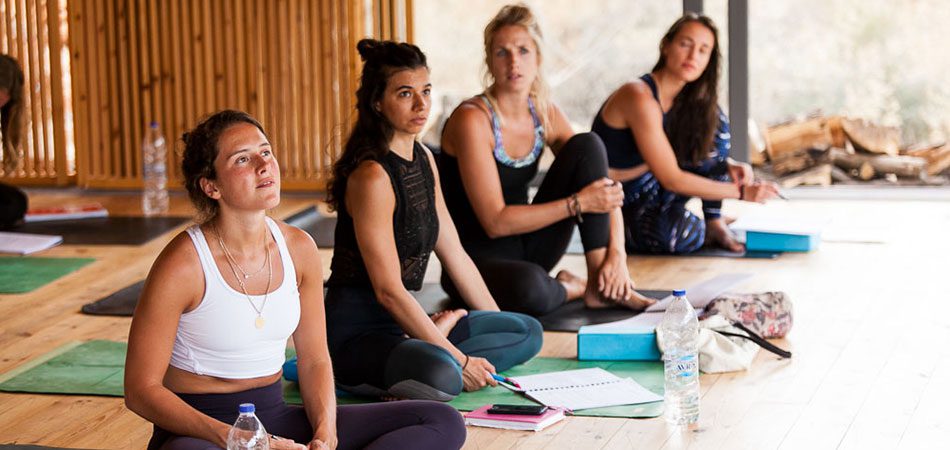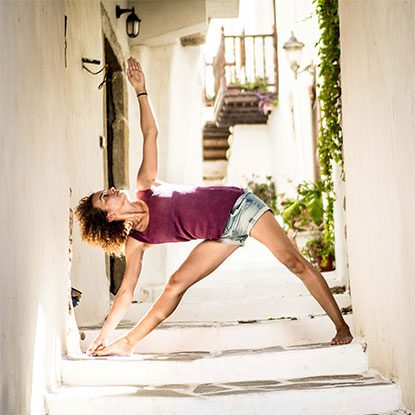
One teaching skill that a good yoga instructor should have is without a doubt demonstrating techniques. There are quite a few techniques for demonstrating an asana and as a yoga teacher, you should know which one to use and when. In this article, we cover the mirror technique of demonstrating an asana. It is rather simple, but it takes some practice to nail it :-))
Make sure that if you choose to demonstrate an asana, you have a reason to demonstrate it. Don't demonstrate it just because you can't cue it. This is what usually happens when you start teaching. You find yourself doing the whole class along with your students and in 5 months you will feel burned out and be wondering why.
I have seen a yoga teacher verbally guiding, doing all the poses with us, sweating, and wiping her face with the towel the whole time. I really felt sorry for her because it must have been very exhausting. The yoga teacher needs to maintain energy for other things, not for demonstrating the whole class.
Make sure that when you demonstrate an asana, you demonstrate it correctly and spot-on. This doesn't mean that you have to go deep, but you need to maintain the main alignment of the pose.
I (Joanna) personally hate it when I have to twist my neck in order to see the teacher demonstrate something. I’m like: "Can you come over here please? I can’t see you."
What’s the point of the teacher demonstrating sth if students can’t see them or if the students need to twist their neck to see the teacher?
This is one of the most challenging techniques but at the same time the most important one: " the mirror technique of demonstrating as asana".
How do you use the mirror technique of demonstratong an asana?
Imagine that there is a mirror between you and your students. This means that you position yourself opposite of the student, facing them (not with your back to them)
As a teacher, you do the asana on your Left side but you guide the student to do the pose on the right side. I will give an example for tree pose and you can read below or watch the video.⠀
You say: ⠀
- Shift the weight on the left leg (you, as a teacher, shift your weight on your right leg) ⠀
- Bring the Right knee towards the chest (you bring your left knee towards the chest)
- Externally rotate your Right leg (you externally rotate your left leg)
- Place your right foot on the left inner thigh. (you place your left foot on the right inner thing)
And voila - you are doing tree on the left side, your student is doing tree on his right side and he is not confused.
If you prefer to watch this in a video, here it is:

What does the mirror technique offer?
The student watches you, listens to you, and does what you are saying and he does what you are demonstrating - there is no confusion.
What happens when the yoga teacher is demonstrating without mirroring and they are guiding you at the same time?
Are you supposed to listen to the instructions or are you supposed to do what they are doing?
Let’s say that the instructor is demonstrating tree pose but he is not mirroring. The teacher will say “ bring your right foot into tree pose” and the teacher will bring his right foot into tree pose. This will be the opposite of your right leg and it’s going to be confusing for your brain because you will see something else other than what he’s telling you to do. And you will be like: Should I do what he is doing or should I listen to what he is saying? ?
This is such an essential demonstrating technique and it can be a bit challenging for the instructor in the beginning, but trust me, like anything else, it gets better with time and practice. Your students will love it because you make it so easy for them. They don't wonder what you mean, they are not confused and they can stay more focused in the present moment.
This is the first demonstrating technique that I teach the students in our 200-hour yoga teacher training. There are other demonstrating techniques as well but this one will distinguish you as a great yoga instructor once you nail it.
In our 300-hour course, we even practice level 2 of this technique. Oh yes, there is a level 2 of this exercise and it’s not easy. This is how it goes:
So the student has now done the pose on his right side, and you as a teacher did the pose on your left side. Instead of staying on the mat and doing the same thing on the second side, you now step off the mat and you keep on verbally guiding your student into this second side. You are no longer mirroring, you guide them verbally and walking in between students so that you can be closer to them and maybe giving micro-adjustments if needed. (you don’t want them to be unbalanced, right?) Video with level 2 starts from minute 03:50.
Watch the video until the end, because there is an important trick at the end of it, which will help you a lot. (It's the trick with the pen)
How do these exercises sound to you? Practice level 1 and level 2. Imagine you have a student in front of you, take the exercise and let me know how it goes, I am curious to find out what you think. How many demonstrating techniques did you learn in your 200-hour yoga teacher training?
Can you think of a pose where this technique wouldn’t work? ?
Interested to learn more techniques and teaching skills for yoga teachers? Check out our 300-hour yoga teacher training in Europe, Greece.
Want to learn more about how our teachers can help you?
9 Important Things to Know Before Choosing the right Yoga Teacher Training Course... for you (Point 4 will really surprise you).





